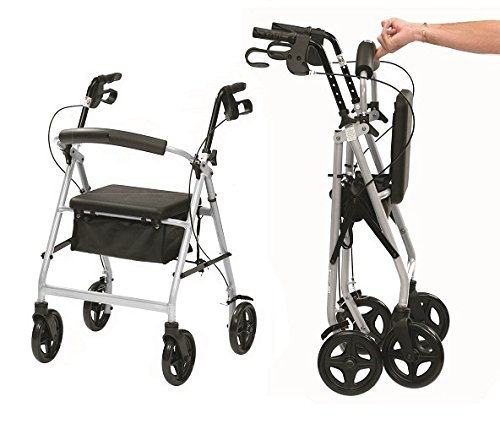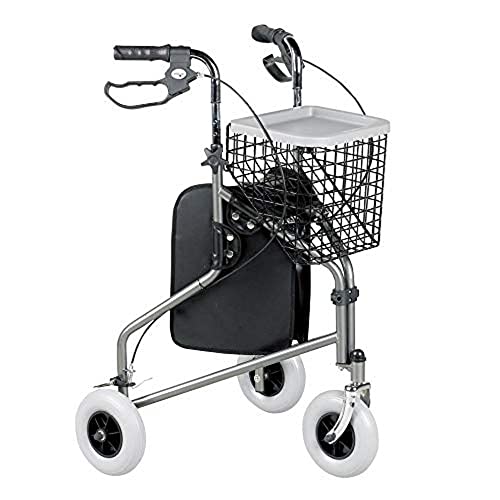See What Rollator Mobility Walker Tricks The Celebs Are Utilizing
페이지 정보

본문
 Rollator Mobility Walker
Rollator Mobility WalkerRollators are a great option for people who have limited mobility and need stability while walking. They come with large wheels, and seats that are built into their frames.
The model comes with padded handles to provide comfort and relieve hand pressure. It comes with adjustable height handlebars as well as the loop locks are designed to prevent the walker from moving while you're resting or sitting.
Comfort
If someone has suffered an injury that impacts their gait and balance or is recovering from hip, knee, or other lower-limb surgeries or injuries, a rollator mobility walker can help. These walking aids offer stability and support to allow users to walk more comfortably while helping them stay active and connected with their family, friends and the community.
These devices are available in various forms, including a traditional walker with no wheels and appears plainer than the rollator walker with all terrain wheels. The handles of walker typically are placed at a level that is most comfortable for the user, making them suitable for anyone who requires stability but still wants to be able to move more easily than with a cane.
The wheels on a rolling walker make it more flexible and easier to use than a standard walking device. The wheels are located closer together, meaning it is easier to steer and maneuver the device in tight spaces. they can also be swiveled for better agility when going up or down stairs. A majority of rollators come with a seat with a crossbar so that users can sit down when they need to.
The handles of a rollator can be constructed from materials that vary in texture and thickness. Look for handles that have soft texture and a soft plastic grip. This is easier to hold for people suffering from arthritis. Be sure to check whether the device comes with loop-lock brakes or lean-activated brakes to accommodate different hand sizes.
Stability
A good rollator walker must include a comfortable and wide seat that users can sit on when they need to take a break from walking. It should be equipped with soft ergonomic grips, brakes that are simple to operate. The grips must be cushioned, and they should be suitable for people who have hand or wrist problems. Some models come with a padded support backrest. You should choose a walker with the weight capacity adequate for your needs, and adjustable handles that can be adjusted to your height.
A locking mechanism for the walker is vital for those who frequently travel or need to transport the walker into and out of their vehicle. It will help to keep the walker from being accidentally opened while in transit, thereby preventing injuries and damages. Take into consideration whether the walker can be adjustable to meet your needs by having removable and interchangeable components.
Researchers conducted a study in order to determine how the strategy for task-performance, and the device load affects the stability of the rollator. Ten participants performed six tasks using an instrumented rolling cane. The researchers measured the combination centre of pressure and base of support, which is referred to as the system Stability Margin (SM). The team found that SM decreased significantly when the person was required to perform other tasks besides straight line walking. They also discovered that leaning against the device can increase the centre of pressure in the base of support and can cause instability to increase or decrease. The researchers conclude that their findings can be used to improve the training to ensure the safety of using a rollator. They suggest that a greater focus should be placed on activities that are not straight line walking and on the specific strategies used to achieve the goals of each task, which may facilitate or hinder stability.
Weight-bearing capacity
A rollator walker is capable of supporting up to 300lbs, or more depending on the model. Its sturdy frame with four wheels will help maintain mobility and balance for those, especially those with medical conditions or who are aging. Rollators are less difficult to maneuver than walkers rollators with standard features that require users to lift their weight to move forward. This reduces hand fatigue.
The wheels on a rollator generally range in size from 6 to 10 inches in diameter, allowing users with the flexibility to use it for indoor and outdoor use on different surfaces. Some models feature a range of height settings for different users. Others fold up for easy storage and transport. Certain models come with a seat that allows users to rest while walking.
Many walkers come with a variety of accessories. For instance a tray for walker or basket for storing personal items. A wrist guard is offered to safeguard your hands from injury, as well as bags for walker's use to carry additional belongings. Some walker frames are also compatible with wheelchairs, making them simple to convert when a person's mobility requirements change.
A bariatric rollator is constructed with a heavy duty frame and wider seat to support larger individuals. It has adjustable handles for height and a wide padded backrest as well as locking hand brakes for the maximum security and safety. The angled handle bars position the hands in a neutral place to reduce fatigue and stress and fatigue, while the convenient storage strap allows it to easily fit into a vehicle's trunk. Its durable 8" wheels are fitted with anti-tip technology that provides greater stability and maneuverability, and the seat is padded to provide an easy place to relax while you travel.
Brakes
A rollator is distinct from a traditional walker. A rollator has wheels that can be controlled independently by hand brakes integrated or located beneath the handlebars. This makes it easier for users to navigate tight spaces and make sharp left and right turns. However, the brakes may occasionally become sloppy or difficult to use, which could be a safety concern for those with declining mobility and limited strength in their hands.
To avoid these issues, many manufacturers provide the option to include brakes that are locked to provide security and stability. This feature is especially useful for those who have difficulty pressing the brakes or applying pressure due to a weak grasp or other health issues such as arthritis. There are some variations in the way the locking brakes are set but most walkers use similar steps to make sure they are properly adjusted.
Before attempting to adjust the lock brakes it is advised to study any maintenance guidelines that come with your mobility aid to find specific instructions. To begin with, locate the brake adjustment knob or screw, which is typically located close to the grips of the handle and tighten it by rotating it clockwise. This is important because if you don't tighten the adjuster in the correct way it will be impossible to get rid of the slack inside the brake cable. After tightening the adjuster screw for brakes then move to the lower adjuster nut and tighten it with the same method. After you have made these adjustments, test the brakes by squeezing them gently and see whether they respond in a timely manner. If they don't it means that the locking mechanism is probably not working properly.
Accessories
There are numerous accessories that can be used by a rollator walker, including cup holders and baskets. Some accessories are designed to carry items while walking, while others, such as the Mobility Phone Grip clip onto the vertical bars on the walker or wheelchair, and expand to hold the phone. The grips can be adjusted to the ideal height for holding your device. Many of these accessories are designed to be lightweight and simple to use, making them ideal for those with hand injuries or arthritis.
The majority of walker and rolling walker manufacturers provide different heights for handles, so you can pick the one that's suitable for your body type. It is also important to take into consideration the capacity of the rollator's weight since this can affect how well it functions for you. While most models are designed to support those who weigh between 300 and 300 pounds, some manufacturers offer models that can accommodate up to 500 pounds.
Another thing to think about when choosing a walker rollator is the type of brakes it has. The brakes that are pushed down work by putting downward pressure on the frame to stop forward motion. Loop brakes operate similarly but require both hands to be used and a bit more force. Both kinds of brakes are a vital safety feature, and it is essential to choose the best option for your needs.
 If you're unsure what type of walker or rollator would be the right one for you, it's recommended that you talk to a physical therapist, doctor or occupational therapist. They can provide advice on the features that are most beneficial for your specific situation, and will help you choose a model that's compatible with any equipment you have at home or hybrid 2 in 1 rollator wheelchair storage.
If you're unsure what type of walker or rollator would be the right one for you, it's recommended that you talk to a physical therapist, doctor or occupational therapist. They can provide advice on the features that are most beneficial for your specific situation, and will help you choose a model that's compatible with any equipment you have at home or hybrid 2 in 1 rollator wheelchair storage.- 이전글Discover Why Frompo Webcam Chat is the Best in Live Streaming 24.11.09
- 다음글시알리스 퀵배송 24.11.09
댓글목록
등록된 댓글이 없습니다.

